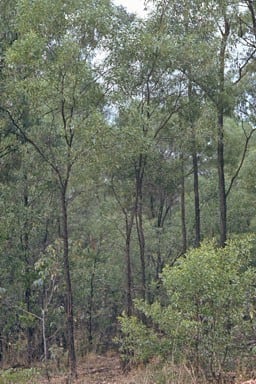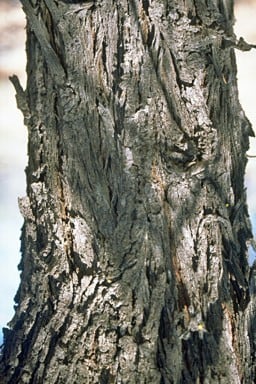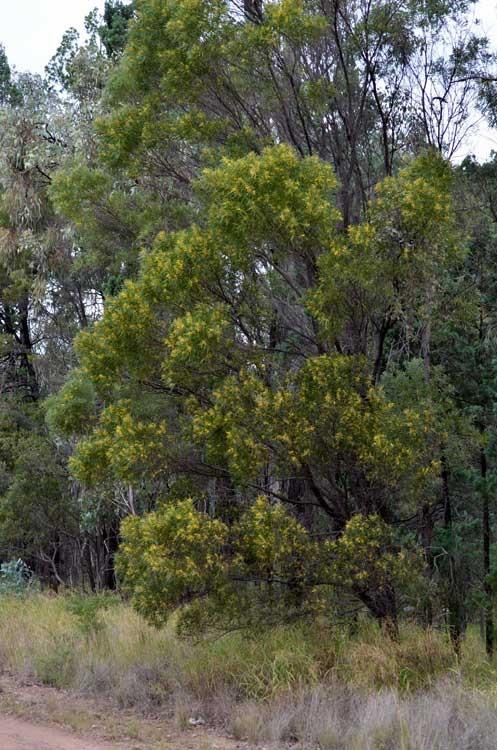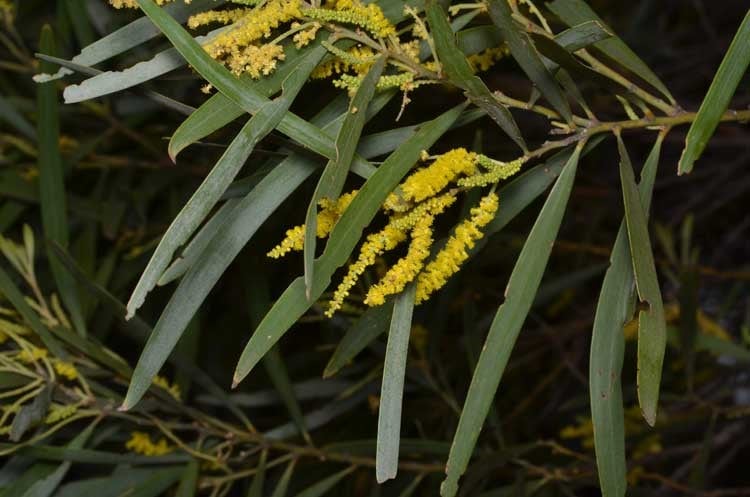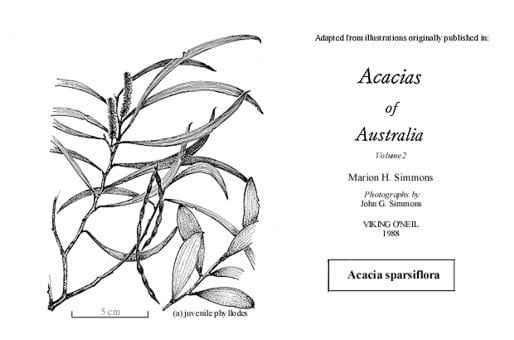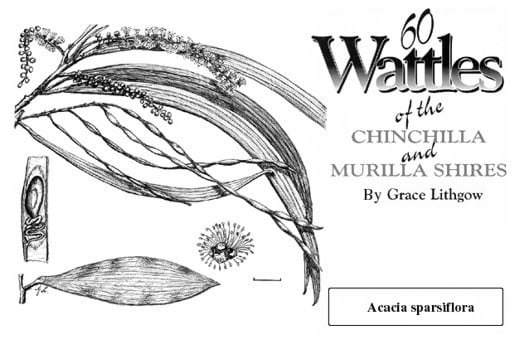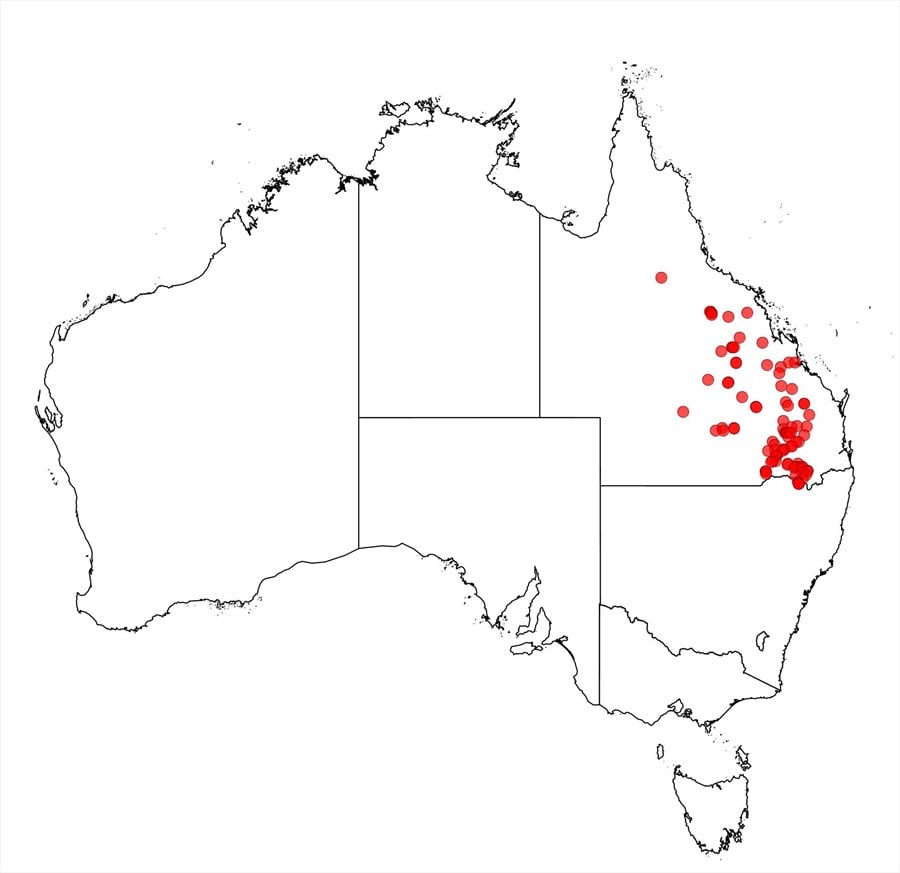Acacia sparsiflora Maiden
WATTLE
Acacias of Australia
Common Name
Currawong, Currawang
Family
Fabaceae
Distribution
Most common in the Darling Downs district, Qld, with scattered occurrences as far N as c. 120 km S of Charters Towers, as far W as near Adavale and S to the vicinity of Yetman, N.S.W.
Description
Tree to 15 m high. Bark rough. Branchlets glabrous or subglabrous (hairy on juvenile plants). Phyllodes (excluding juvenile plants) falcately recurved, rarely straight, narrowed at both ends, (6–) 8–16 (–22) cm long, (3–) 5–12 mm wide, thinly coriaceous, grey-green, glabrous or sparsely appressed-puberulous, with numerous fine close non-anastomosing nerves, of which 1–3 more prominent. Inflorescences binate, rudimentary racemes; raceme axes 0.5–4 mm long, normally terminated by a dormant vegetative bud, sometimes growing out at anthesis; peduncles (3–) 5–10 mm long, glabrous or sparsely appressed-puberulous; spikes 2–4.5 cm long, bright lemon-yellow, sometimes pale yellow. Flowers 5-merous; sepals united into a sinuate-toothed, glabrous calyx; ovary densely hairy. Pods shallowly constricted between and slightly convex over seeds, to 9 cm long, 2–3 mm wide, thinly coriaceous, brown with yellow margins, glabrous. Seeds longitudinal, oblong, 4–5 mm long, shiny, dark brown to blackish; funicle/aril folded below seed.
Habitat
Often forms dense stands, sometimes with A. shirleyi, in shallow stony soil, often over weathered sandstone, in the 625–750 mm annual rainfall belt. Also occurs in eucalypt woodland and open forest.
Specimens
Qld: 5 km W of Clermont T/S, Adams 1271 (BRI, PERTH); on Warrego Hwy, W of Baking Board, between Chinchilla and Miles, M.G.Lithgow 954 (BRI); 5 km SE of Ula Ula HS, V.J.Nelder & M.B.Thomas 461 (BRI); western boundary of Milo Holding, c. 13 km WNW of Gooyea outstation, NW of Adavale, R.W.Purdie 2057 (BRI). N.S.W.: 9 km from Yetman on Texas road, A.N.Rodd 4110 (B n.v., BRI n.v., CANB n.v., K n.v., MEL n.v., NSW, NY n.v.).
Notes
Young plants have silvery sericeous or (on Bancroft’s ‘Eidsvold’ collection) puberulous branchlets and phyllodes. Furthermore, their phyllodes are elliptic to narrowly elliptic, 3–5 cm long, 10–20 mm wide and straight. Mature plants are glabrous to subglabrous and have markedly falcate phyllodes mostly 8–16 cm long and 5–12 mm wide; trees with ‘intermediate’ foliage resemble A. burrowii but the two species are not closely related.
The leaves are eaten readily by stock and the trees are cut for fodder in times of drought.
In the absence of pods mature plants could be confused with A. spirorbis subsp. solandri which can be distinguished by phyllode nerves more widely spaced and sparingly anastomosing, and spikes rarely on a much-reduced raceme.
FOA Reference
Data derived from Flora of Australia Volumes 11A (2001), 11B (2001) and 12 (1998), products of ABRS, ©Commonwealth of Australia
Author
B.R.Maslin, R.S.Cowan
Minor edits by B.R.Maslin & J.Rogers
This identification key and fact sheets are available as a mobile application:
URL: https://apps.lucidcentral.org/wattle/
© Copyright 2018. All rights reserved.

